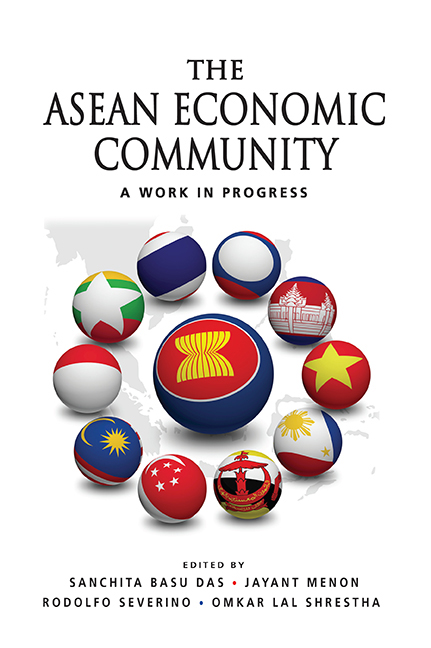Book contents
- Frontmatter
- Contents
- Foreword
- Foreword
- Preface
- acknowledgments
- Abbreviations
- The Contributors
- 1 Overview
- 2 Non-Tariff Barriers: A Challenge to Achieving the ASEAN Economic Community
- 3 ASEAN Trade in Services
- 4 The Asean Economic Community: The Investment Climate
- 5 Competition and Intellectual Property Laws in the ASEAN ‘Single Market’
- 6 Subregional Zones and ASEAN Economic Community
- 7 ASEAN FTAs: State of Play and Outlook for Asean's Regional and Global Integration
- 8 The Asean Dispute Settlement System
- 9 Enhancing the Institutional Framework for AEC Implementation: Designing Institutions that are Effective and Politically Feasible
- 10 ASEAN Economic Community Business Survey
- Index
9 - Enhancing the Institutional Framework for AEC Implementation: Designing Institutions that are Effective and Politically Feasible
Published online by Cambridge University Press: 21 October 2015
- Frontmatter
- Contents
- Foreword
- Foreword
- Preface
- acknowledgments
- Abbreviations
- The Contributors
- 1 Overview
- 2 Non-Tariff Barriers: A Challenge to Achieving the ASEAN Economic Community
- 3 ASEAN Trade in Services
- 4 The Asean Economic Community: The Investment Climate
- 5 Competition and Intellectual Property Laws in the ASEAN ‘Single Market’
- 6 Subregional Zones and ASEAN Economic Community
- 7 ASEAN FTAs: State of Play and Outlook for Asean's Regional and Global Integration
- 8 The Asean Dispute Settlement System
- 9 Enhancing the Institutional Framework for AEC Implementation: Designing Institutions that are Effective and Politically Feasible
- 10 ASEAN Economic Community Business Survey
- Index
Summary
Introduction
The institutional structure supporting the ASEAN Economic Community (AEC) project remains limited. Despite the many suggestions proposed over the years for institutional strengthening, and despite ASEAN adopting a number of these proposals, ASEAN's institutional architecture for regional integration continues to emphasize political or discretionary approaches and little in the way of authority delegated to third parties or to the ASEAN Secretariat for enforcing compliance. ASEAN member states are well known for resisting any form of centralized authority to manage and complete the integration process. It is also important to recognize that this penchant for weak institutions, in fact, reflects weak preferences for integration or, at least, for particular aspects of the regional integration agenda. This means that any proposal aimed at reworking regional institutions to support integration must consider institutional designs that are politically feasible so that these will more likely be adopted by ASEAN governments. Ideally, institutions should also be crafted so that they can help to change national preferences in favor of a deeper commitment to regional integration that will, in turn, ensure timely and effective implementation.
This chapter explores how best to design regional institutions to enhance AEC implementation. It begins with a political economy account of regional integration in Section 2 that helps us understand the factors that drive ASEAN countries' national commitment to regional integration as well as those that hold back these same governments from fully implementing these commitments. By doing so, we are better able to appreciate the ASEAN aversion to strong, centralized institutions and the preference for flexibility in the way regional integration is designed. Section 3 draws on the political science literature to consider how institutions might theoretically be designed to support cooperative projects like economic integration; this section also reviews the various institutional mechanisms adopted in ASEAN to support the AEC project. Based on the preceding discussion, Section 4 provides some suggestions on how institutions in ASEAN might be re-designed to support the AEC process in the light of national and regional political realities.
The Political Economy of ASEAN Integration: Understanding ASEAN's Preference for Flexibility
Three features characterize ASEAN's approach to regional economic liberalization and integration, seen in both the AFTA project initiated in 1992 and the current AEC project. First, ASEAN governments have generally been forthcoming in initiating ambitious plans and programs on economic cooperation and liberalization.
- Type
- Chapter
- Information
- The ASEAN Economic CommunityA Work in Progress, pp. 411 - 441Publisher: ISEAS–Yusof Ishak InstitutePrint publication year: 2013



